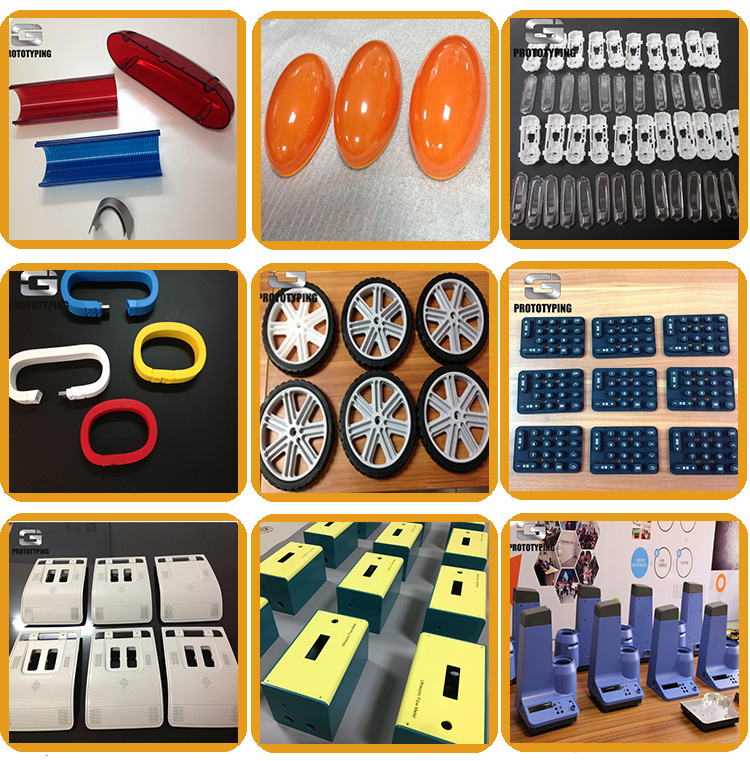WHAT IS VACUUM CASTING?
Vacuum casting involves making a mold out of silicone rubber, usually based upon a master model created by CNC machining or one of our rapid prototyping services.
VACUUM CASTING
We made a master model using stereolithography (SLA), a 3D printing technology.The main pattern can be any solid material, they are excellent candidates, 3D printing plastic such as SLA, SLS. main mode need to be carefully done, because the silicon die to do a good job, even tiny details surface transfer to any subsequent copies.
MATERIALS
Hundreds of casting polymers are commercially available to reproduce any conceivable hardness and surface texture. It is also possible to make parts that are fully opaque, translucent or completely transparent depending on your application. See more information on available materials.
We made a silicon mold according to the template to form a master pattern using the customer's 3D product design. Once the master mold was created we could start the vacuum casting replica.The typical mold is a good high fidelity replica of around twenty, ideal for rapid prototyping with minimal cost.
Machining Services
Material Capabilities: ABS, POM, PP, PC, PE, PA(Nylon), PC+GF,Resin,Silicone and etc
Color: can be customized
MOQ: 1 piece
Files format: .IGS .STP .STL .X-T
Surface treatment: Polish, Painting, Silk-printing, UV coating, Electroplating,etc
Business type: OEM manufacturer
ADVANTAGES OF VACUUM CASTING:
Vacuum casting is an ideal choice for rapid prototyping because:
1.There is a low initial cost since it doesn’t require investment in tooling;
2.The high fidelity of the mold gives excellent surface details requiring little or no post-processing;
3.Many different molding polymers are available that can be pigmented to meet your color requirements;
4.Molds can be ready in a few days once the master model has been created;
5.Molds are durable up to approximately 50 copies so it’s great if you need more than one copy;
6.We provide overmolding, so that different types and hardnesses of plastic can be molded together into a single unit;
7.It is an excellent option for testing multiple variations of a prototype design for rapid product development.
VACUUM CASTING PROCESS:
Stage One: Making the Master Mold
1, A solid master model or pattern is required. This can be made of any stable material, and can either be supplied by you or alternately created by Gaojie Model using our 3D printing services or via CNC machining.
2, Typically master patterns are made in plastic or metal, the only requirement being that they are able to withstand a temperature of 40° C for an extended period of curing.
3, We then suspend this pattern inside of a casting box, which we half-fill with liquid silicone rubber. This is placed inside of a curing oven and heated at 40° C until the silicone is fully cured.
4, The casting box is then filled with additional silicone liquid which is also heated and cured. The two halves are treated with a releasing agent for later separation.
5, Once fully cured, the silicone rubber mold is opened up along the parting line and the original master removed.
STAGE Two: MAKING THE PARTS
1, During mold making, our craftsmen strategically place a series of fine holes surrounding the master pattern. These holes will be used to later draw air pressure out of the mold.
2, Once the master has been removed, there is now a hollow cavity in the silicone mold which is an exact reverse image of the original.
3, We can fill this cavity with any number of molding polymers to suit your design requirements. Once the cavity is filled, it’s placed into a vacuum chamber which draws air out of the cavity and pulls the liquid plastic into all of the recesses of the mold, ensuring an exact conformity to the original shape.
4, Finally the mold goes into a curing oven one more time, creating a solid and stable replica of your original master pattern.

TOLERANCES
The finished dimensions of vacuum cast parts is dependent on the accuracy of the master model, part geometry and casting material. In general, a shrinkage rate of 0.15% is to be expected.
ARE YOU READY TO START YOUR NEXT PROJECT?
We’re proud to say that our vacuum cast parts have helped to pave the way towards full-scale production on many successful and famous products used in commercial, industrial and scientific applications around the world. We’re confident we can meet and exceed your expectations just as we’ve done for thousands of customers before. Contact us today for a free design review and quotation.
Copyright © 2016 Design by Gaojie Model | Sitemap